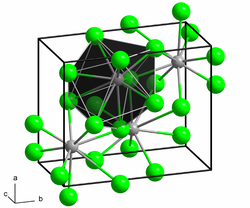Radium bromide
| Crystal structure | |||||||||||||
|---|---|---|---|---|---|---|---|---|---|---|---|---|---|

|
|||||||||||||
| __ Ra 2+ __ Br - | |||||||||||||
| General | |||||||||||||
| Surname | Radium bromide | ||||||||||||
| Ratio formula | RaBr 2 | ||||||||||||
| Brief description |
white solid |
||||||||||||
| External identifiers / databases | |||||||||||||
|
|||||||||||||
| properties | |||||||||||||
| Molar mass | 385.83 g mol −1 | ||||||||||||
| Physical state |
firmly |
||||||||||||
| density |
5.78 g cm −3 |
||||||||||||
| Melting point |
728 ° C |
||||||||||||
| solubility |
|
||||||||||||
| Hazard and safety information | |||||||||||||
 Radioactive |
|||||||||||||
|
|||||||||||||
| As far as possible and customary, SI units are used. Unless otherwise noted, the data given apply to standard conditions . | |||||||||||||
Radium bromide is a white solid that glows by itself in the dark . Over time, radium bromide turns yellowish due to radiolysis .
Extraction and presentation
Anhydrous radium bromide is produced by reacting the chloride with gaseous hydrogen bromide for several hours in a red heat . The dihydrate RaBr 2 · 2 H 2 O of radium bromide is obtained by dissolving radium carbonate in hydrobromic acid and subsequent crystallization.
properties
Radium bromide crystallizes out as a dihydrate from aqueous solution, which is isomorphic with barium bromide BaBr 2 · 2H 2 O. The dihydrate can be dehydrated by passing dry air at 200 ° C over it. The freshly crystallized salt is colorless, but turns yellow over time through radiolysis through alpha radiation . The helium created in the crystals can cause the crystals to burst.
Individual evidence
- ↑ a b c d e f g h i Kirby, HW and Salutsky, Murrell L. (1964) The Radiochemistry of Radium , Subcommittee on Radiochemistry, National Academy of Sciences, accessed February 28, 2017.
- ^ William M. Haynes: CRC Handbook of Chemistry and Physics, 97th Edition . CRC Press, 2016, ISBN 978-1-4987-5429-3 , pp. 100 ( limited preview in Google Book search).
- ↑ The hazards emanating from radioactivity do not belong to the properties to be classified according to the GHS labeling. With regard to other hazards, this substance has either not yet been classified or a reliable and citable source has not yet been found.
- ↑ Gmelin's Handbook of Inorganic Chemistry: Radium, System Number 31, Eighth Edition, Verlag Chemie GmbH, Berlin 1927, pages 61-62.
